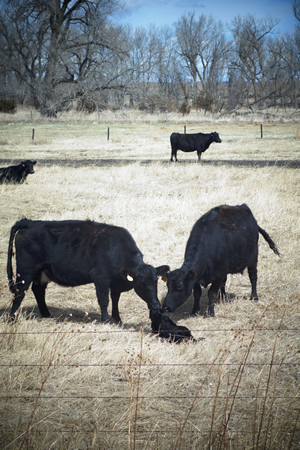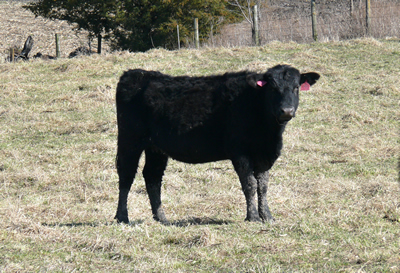Calving Management
Body Condition Scoring
The use of body condition scores (BCS) is a labor extensive, non-invasive tool to assess if cows are receiving the proper nutritional intake to meet their metabolic needs. It is a fairly simple technique to learn that does not require scales or added labor to work cattle through handling facilities. Many producers assess body condition in the fall when calves are weaned and cows are pregnancy checked. However, it is just as pertinent, if not more so, that BCS be monitored through the winter and cows are kept in adequate condition prior to calving. However, it can be difficult to accurately estimate body condition on late term cows in the middle of winter. Late gestation cows have an enlarged abdomen because of the growing fetus and a heavy winter hair coat can decrease visibility of bony structures such as ribs and vertebrae that are commonly used as reference points for determining BCS. To the untrained eye, gut fill and hair may be interpreted as flesh. Thus, careful scrutiny must be used to effectively monitor BCS.
BCS at calving is associated with dystocia, calf vigor, colostrum production, calf immunity, and rebreeding. One specific study showed that calves born to heifers at a BCS of 3 took an average of 60 minutes to stand while calves born to heifers at a BCS of 6 took only 35 minutes. Similarly, heifers that calved at a BCS of 2 produced 750 ml of colostrum while BCS 5 heifers produced almost twice as much colostrum. The immunoglobulin level of calves was 1788 mg/dl and 2348 mg/dl for calves born to heifers with a BCS of 2 and 6 respectively. Other studies have shown that time to estrus after calving is related to BCS. Females calving at a BCS of 3 had a postpartum interval of 89 days while females that calved at a BCS of 7 had a postpartum interval of 31 days. Similarly, pregnancy rates are lower in females that calve at lower body condition.
For more information on how to body condition score, visit http://beef.unl.edu/learning/condition1a.shtml or http://aces.nmsu.edu/pubs/_circulars/CR575.pdf
| Contributors | |||||
|---|---|---|---|---|---|
| Grant Dewell | Renée Dewell | Katy Lippolis | |||
Associate Professor |
Veterinary Specialist Center for Food Security/Public Health rdewell@iastate.edu 970-231-9654 |
||||


